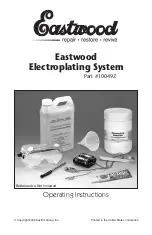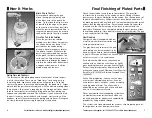
To order parts and supplies, call 1-800-345-1178 or visit www.eastwood.com
5
4
For technical assistance e-mail: [email protected]
As with any restoration or decorative process, the finished product is
only going to be as good as the preparation. The actual electroplating
process is only the final step. Any flaws found in the part before plating
are still going to be there after the plating, unless you prepare properly.
If you want the finished piece to have a mirror-like shine, buffing the
part before plating will be necessary.
1. DISASSEMBLE OBJECT TO BE PLATED
First, any object to be plated should be disassembled into individual
pieces. Nothing should be left bolted together if possible.
2. REMOVE ALL GREASE, OIL, PAINT, OR RUST
All parts should be free of grease, oil, paint, or rust. Old paint may be
removed by abrasive blasting, paint remover, or sanding. Eastwood carries
many products which can aid in this process. To ensure that the parts are
chemically clean, we recommend that they be soaked in Eastwood’s Fast
Etch Rust Remover and then rinsed before plating.
3. CLEAN WITH A MILD DETERGENT
After surface preparation, all parts should be cleaned with a mild
detergent, followed by a wax and grease remover. We recommend
Eastwood’s PRE Painting Prep (#10041Z).
4. CLEAN IT AGAIN!
There is a general rule that should be followed for any kind of
plating preparation: when you think the part is clean enough to
be plated,
clean it again!
For best results and enhanced corrosion
protection, use Eastwood’s Fast Etch (#19416Z pint or #19418Z gallon).
Allow Eastwood’s Fast Etch to chemically clean the part for about 10
minutes or longer, as needed to assure all rust is removed. Rinse in clean
running water and immediately (do not let the part dry) place it in the
plating bath.
5. HANDLE CLEANED PARTS WITH GLOVES
It is very important that you do not handle the cleaned pieces with your
bare hands. You may leave traces of oil on the part which will cause
problems. Cleaned parts should be handled with gloves or pliers, being
careful not to scratch them.
6. PLATE THE PREPARED PARTS RIGHT AWAY
Parts that are cleaned are subject to corrosion quite rapidly; this is called
“flash rusting”. For this reason, it is very important that the parts be plated
as soon as possible after preparation.
Shake the Solution in Original Container
Due to the nature of the electrolyte, some settling of chemicals may
occur. Check to make sure the lid is secure, then shake the solution to
ensure a uniform mixture of the contents. Some sediment is normal and
will not affect performance.
Put Container on a Level Surface
and Hook Anode Bar Over the Rim
After shaking the solution, pour it into
a wide mouth plating container then
place it on a level surface. Take the
anode bar and hook it over the rim
(mouth) of the container allowing it to
hang into the plating solution.
Attach the Wire to The Anode
Attach the small silver alligator clip
on the
red (positive) wire
to the
end of the anode bar which is
hanging over the end of the solution
container.
It is very important that
you do not allow this clip to enter
into the plating solution as this may
contaminate it.
The
black (negative)
wire
attaches to the part you will
be plating. Note: Be sure positive
battery post is touching battery
holder contact
NOTE:
For safety purposes, we recommend that you set up your plating
system as close as possible to a water source. Eastwood does not
recommend that you use your kitchen counter due to the proximity of
food, and that the electrolyte may discolor some decorative counter
tops. If a running water source is not available, several buckets of
fresh rinse water will be sufficient.
Setting Up The System
Preparing Parts For Plating























